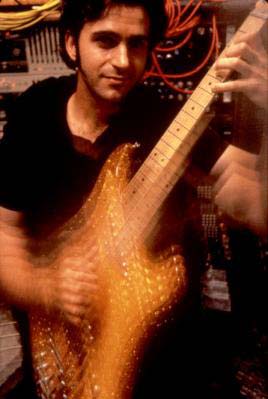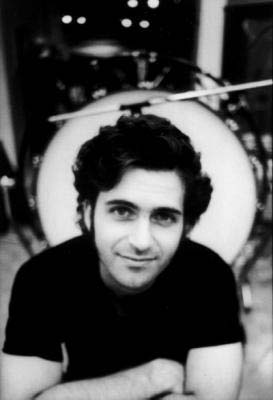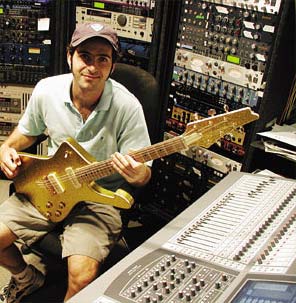Volume 3, Number 2, April 2005
[UA Universe] [Ask the Doctors] [Digital Minds] [Analog Obsession]
[Support Report] [The Channel] [Plug-In Power] [Analog Ears] [Featured Promotion]
[Graphic-Rich WebZine]
[Back Issues] [UA Home]
Digital Minds
Dweezil Zappa
Part 1: Digital Technology Lets Him Duet With Dad
Interview by Marsha Vdovin
 |
|
Dweezil Zappa
|
This interview with Dweezil ended up yielding so much great information that we've split it into two parts. In part one, we discuss Dweezil's renovation of his dad's studio, and reissues of his Dad's work. Next month, part two will focus on Dweezil's solo album, upcoming tour and his experience with the UAD-1 card. So, first up, refurbishing Frank Zappa's infamous Utility Muffin Research Kitchen, which turned out to be a major task.
"The main thing that we wanted to do," recalls Dweezil, "was bring it up to date in the modern production world. It wasn't a computer-based studio. The entire room itself didn't sound right to me, so we basically started from scratch and rebuilt it. The control room never had a machine room before, so there was a lot of construction. It's a great space to work now.
“Quaudiophiliac has a combination of mixes that are either in quad or in full surround, including several tracks that have never been released, as well as some surprises. It was my job to bring them all together into a listening sequence that made it fun.”
"There's a digital console--it's a Euphonix System 5--and we have two different digital recording systems. We have the Euphonix R1 and Nuendo. Then we have analog tape machines. We really needed to rethink and update the studio, because we weren't able to follow through on projects of Frank's, such as archiving properly. Over time, tape sort of deteriorates and we need to put it another format. Unfortunately, there is no real standard format in the industry for archiving. This archiving is going to be an ongoing project for years. There are a lot of issues. We have a guy working with us named Joe Travers, and we call him 'the Vaultmeister.' He's the one who gets to go into the vault, inspect the tapes, listen to them and tell us what's on them. A lot of times there may be something written on them, but that's not necessarily what's actually on the tapes; it could be something entirely different. Frank was known for recording over his own work and doing 'special projects.' We run into that a lot, and it usually hasn't been documented.
.
"Right now I'm using JBL LSR 6328P's monitors and a 6312SP(sub) for both stereo and surround," Dweezil continues. "I really like them; they given me a true response. I have a workstation and I have a mix position station, so the room is being utilized in two ways. You get a different perspective from each station, and then you can also go ahead and make references and listen to them in other rooms. It works well for me to move around the room to hear and feel what kinds of differences there are. In one area you'll make use of the sub, and in another area you don't. It's really helped to hone in on problem areas in certain mixes. I think there's probably a couple of things that the room needs to be looked at in terms of voicing and certain types of frequency build-up in certain areas. For the most part, it's really pretty accurate." Frank Zappa actually only released a small percentage of his recordings. So, there's a lot of raw material for Dweezil to inspect.
 |
The second release was Quaudiophiliac, also on DVD-Audio. Credited as produced by Frank Zappa and Dweezil Zappa, it includes a bunch of quad mixes that Frank did over the years, starting as early 1970.
"The project started when we found a box that had a drawing on it that diagrammed where the mics were placed in the room, and the box was labeled quad. It was a drawing to re-create the room where it was recorded. It included a song that was called 'Chunga's Revenge.' It became something else further developed later on, but this early version was recorded in the original basement studio in the house. You really feel like you are there at the session, and it's conceivably the first time the song was recorded. There are a few start and stop moments which we left in the recording. Quaudiophiliac has a combination of mixes that are either in quad or in full surround, including several tracks that have never been released, as well as some surprises. It was my job to bring them all together into a listening sequence that made it fun. It's a cross section of music covering about fifteen years of his career. One cool thing was taking a piece of audio that had Frank talking about the music industry and record companies, and I superimposed it over one of Frank's songs called 'Watermelon and Easter Hay.' I mixed that in 5.1 and created some segues to improve the continuity. A lot of people have commented that it's a strange joyride that they get to go on, and the surround experience draws them in."
One of the upcoming projects Dweezil plans to attempt is a surround remix of one of Frank's classic releases:
"I can't wait to go from the ground up on a classic record," he says. "The problem we will encounter is the way that Frank worked. He would often take stuff from alternated takes and build something out of it, and insert it into something else. That stuff is usually not documented, so even if you have the master tape and the stereo mixes, if you go to the source tape you won't find everything there. Our challenge will be to either find those little snippets or re-create them. If it can't be done, then we can't do a complete version of those classic records. We've recently transferred the master tapes of Hot Rats, where everything is intact but we discovered a lot of interesting things about it.
 |
"He had done all these special recording tricks, and it's really cool to discover them. I'm actually going to do a version of 'Peaches' for my new solo record where I play along with the master tapes. I'll play a lot of the guitar parts and some of the melodies, but I'll leave Frank's guitar solo and some other original things in, so it will appear that we are playing together. It should be a cool combination of new and old."
I think Frank would approve. Next month we'll discuss Dweezil's upcoming solo release and get in to more detail about his working technique and use of the UAD-1 card.